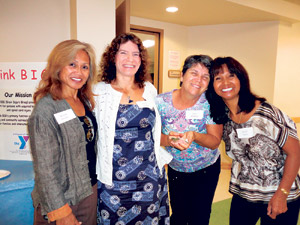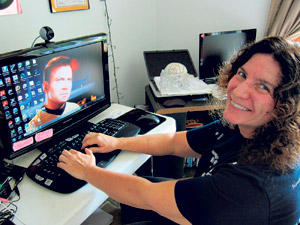Thinking B.I.G. With Brain Injuries

Louanne Varholick (second from left) at the 2012 Think B.I.G. Conference with (from left) Marida Dorado, Suzie Woolway and Sharon Pancho | Coco Zickos photos
Powerful healing takes place when you know you’re not alone. That’s why clinical neuropsychologist Louanne Varholick spends so much of her free time as volunteer director of Think B.I.G. (Brain Injury Group) Kaua’i.
The organization hosts therapeutic meetings each month for survivors of brain and spinal cord injuries, as well as their family members and/or caregivers. As head of the nonprofit, Varholick helps provide support, education and outreach.
“There is no substitute for having a group of people who can really understand firsthand what it is you struggle with,” says the Wailua resident.
Think B.I.G. is an entirely voluntary program under the ‘Ohana YMCA of Kaua’i.
“A lot of people don’t have a lot of money right now, in general, to be paying,” explains Varholick. “So you do it because you love it and you want to educate the public, and you realize that what comes around goes around.”
Meetings are facilitated by Varholick, who enjoys working with people with acquired disabilities.
“I love people, and I feel especially protective of people who are challenged in this way,” she says. “Unless there is somebody else to encourage them and help advocate for them, they find that they really are their own advocates.
“So you need a warrior on your side to help give you that push and the encouragement.”
A large part of Varholick’s professional life is meeting one-on-one with people who have sustained traumatic brain and spinal cord injuries. She also assists those who have disabilities from conditions such as stroke and multiple sclerosis.
Often, injuries are hidden and don’t manifest as impaired limbs or dysfunctions in movement. They can include memory challenges. Varholick serves as a brain detective, determining what ails her clients.“I get to figure out the mystery about why the person is different,” she says, adding that the injuries can be temporary, permanent or even stress-related.
Clinical neuropsychology is the study of the brain, behavior and relationships. It’s a profession that Varholick turned to after learning she couldn’t follow through with the dissections required to become a medical doctor.
“I couldn’t cut into things,” she admits.
Originally from Ohio, Varholick moved to the island four years ago. Since then, she has helped diagnose many clients’ disabilities and serves as a liaison to physicians regarding neural conditions and how to slow them down so that they don’t have as much effect on the brain.
Varholick works with ages 16 and older. She has an intimate knowledge of the diseases and problems in the body that affect the central nervous system of the brain and spinal cord. For the elderly, she can determine whether someone is aging normally or is afflicted with a disease such as Alzheimer’s.
“I give people the peace of mind,” she says.
In younger clients, learning disabilities like attention deficit disorder are professionally diagnosed.
“I kind of think I was born to do this,” says Varholick, who while growing up always befriended those who didn’t quite fit in, and even had a disabled dog as a pet.
She also works with women who have minor head trauma from repeated abuse.
“The issue of women who have been battered over the course of the years and the fact that they may have brain injury is an issue that is underappreciated,” she says.
The problem is more neuropsychiatric, a flight or flight response to taking multiple hits to the head.
“And I think that even the women themselves might not be quite aware that they have a brain injury,” says Varholick.
Helping them realize that they are not unintelligent, that they are actually having difficulties functioning neurologically is a profound healing experience.
Helping those with disabilities feel better continues to bring joy to Varholick, and it’s why she dedicates whatever free time she has to Think B.I.G.
People are encouraged to attend the group as little or as often as they want.
“We just keep people engaging and talking and laughing,” says Varholick of the meetings. “If something gets really emotional and somebody needs to cry, we’re supportive of that.”
She also explains that it is a confidential environment.
“We encourage everyone to respect the fact that what goes on within the meeting should stay within the meeting,” she says.
Think B.I.G. also has a relationship with Kaua’i’s Paratransit service to help people from across the island attend meetings.
“We know what an effort it is for them to do it, but we know how therapeutic it is,” she says of folks who are wheelchair-bound.
Future plans for the organization include raising funds so that scholarships can be offered to participants to travel to Honolulu to attend Brain Injury Association events. Also currently in development is a noncredit course designed for brain-injured individuals and their caregivers to teach living skills to others.
March is Brain Injury Awareness Month. For more information, visit biausa.org/brain-injury-awareness-month.htm.
For more information about the monthly Think B.I.G. meetings, visit thinkbigkauai.com.




